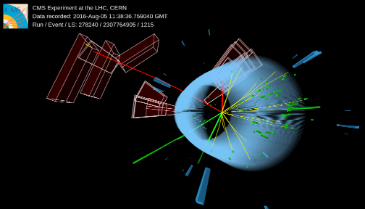Evidence for coupling of the Higgs boson to muons
Evidence for coupling of the Higgs boson to muons
Publication highlight: Prof. Martin Grunewald
Journal reference: (opens in a new window)J. High Energy Phys. 2021, 148 (2021)(opens in a new window)
A new result released by the CMS Collaboration presents evidence of the Higgs boson interacting with the muon. Members of the School of Physics at UCD were responsible for the high-level trigger system to record the data analysed.
The standard model of particle physics describes all the known fundamental particles in the Universe. A mystery of the standard model is the vast spread of observed particle masses. The particles in the standard model have masses ranging from the very nearly massless neutrino to the top quark, with a mass several hundred thousand times heavier than that of the electron. The Higgs field, which plays a critical role in describing the particle masses, is postulated by the standard model to permeate all space. The strength of the interaction between the Higgs field and every particle then explains each particle's mass. While we know that the Higgs field gives particles mass, we do not understand why it gives different particles different mass.
The Higgs boson was famously discovered by the ATLAS and CMS Collaborations in 2012 and is the observed quantum particle associated with the Higgs field. Higgs bosons produced in LHC proton-proton collisions disintegrate (decay) nearly instantaneously to other fundamental particles. By measuring the Higgs boson decay rate to a particle, we can infer the interaction strength between the Higgs field and that particle. Therefore, these measurements directly test the predicted mechanism by which particles acquire mass. Since the Higgs boson discovery, there has been an enormous effort to understand how the Higgs boson couplings with the other fundamental particles compare with the precise predictions of the standard model. The measurements performed so far have focused on the Higgs boson interactions with the most massive particles, such as the W and Z bosons, and only with particles from the most massive generation, the top and bottom quark and the tau lepton. The interaction of the Higgs boson with the large span of lighter particles is so far experimentally untested. Measuring the full spread of Higgs boson interactions is a critical test necessary to understand whether the Higgs field can explain the full range of particle masses. Measuring the interaction of the Higgs boson with the muon, with a mass nearly two thousand times smaller than that of the top quark, is the next experimental frontier. Doing so will allow examining the Higgs field interactions with particles belonging to a different generation for the first time, and at a so-far untested mass scale.
The Higgs boson decay to muons is very rare, with only about one in five thousand Higgs bosons predicted to decay to muons. Adding to the challenge, for every predicted Higgs boson decay to muons at the LHC, there are about one thousand muon pairs that mimic every single Higgs boson. This background from other particles (like Z bosons) makes isolating the Higgs boson decay to muons at the LHC extremely difficult.
The analysis is performed using proton-proton collision data at a centre-of-mass energy of 13 TeV, corresponding to an integrated luminosity of 137/fb, recorded by the CMS experiment at the CERN LHC. The measurement sensitivity has been improved significantly compared to previous results. Four separate analyses were necessary to identify candidate signal events from the different modes by which Higgs bosons can be produced. The background prediction strategy includes sophisticated machine learning techniques like deep neural networks that help to differentiate the signal from the substantial background. The characteristic expected signature of the Higgs boson decay to muons is a small excess of events in the invariant mass of muon pairs near the Higgs boson mass of 125 GeV. An excess of events over the back-ground expectation is observed in data with a significance of 3.0 standard deviations, where the expectation for the standard model (SM) Higgs boson with mass of 125 GeV is 2.5. The measured signal strength, relative to the Standard Model theory expectation, is 1.19 +-0.40 (stat) +-0.15 (syst).
| FIG. 1: Event in which a candidate Higgs boson produced in association with a Z boson (ZH) decays into a pair of muons, indicated by the solid red lines | FIG. 2: The di-muon invariant mass distribution for a weighted combination of all event categories. The lower panel shows the residuals after background subtraction with the best-fit signal contribution indicated by the red line. |
|---|---|
 |
-341x356.png) |